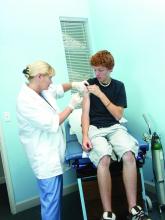User login
The Pill: A pediatric perspective
Arguably, the introduction of the birth control pill has transformed female health more than any other drug in modern medicine. Although many of us practicing now do not know life without it, its history is not that long.
“The Pill” – as it is often referred to – was introduced in May of 1950.1 At that time, prevention of pregnancy was not listed as an indication, and promoting birth control was politically, socially, and legally unacceptable. In fact, the Comstock Law prohibited public discussion and research about contraception.1 Therefore, when the birth control pill was introduced, it was for cycle control and for married women only. It was not indicated for use as contraception in the United States until 1960.
Since that time, the birth control pill has evolved dramatically, not only in its formulation but in its indications as well. As pediatricians, we do not always find it easy to discuss with parents hormonal regulation and starting a patient on the birth control pill, particularly when it will not be used for contraception. There are many fears about using hormonal control, but there are many useful indications that improve the health and well-being of the pediatric patient.
Menorrhagia and dysmenorrhea are likely the most common reasons that hormonal therapy is started in adolescence. Beginning with the lowest estrogen dose to reduce side effects is prudent, adjusting accordingly if side effects should occur. Breakthrough bleeding is a common side effect that usually improves over time. Patients should continue treatment for at least 3 months before deciding if treatment is effective or not. If breakthrough bleeding continues, increasing the estrogen component or changing to a triphasic pill might reduce bleeding.
For a child with mental or significant physical disabilities, suppression of ovulation to prevent a menstrual cycle is very useful. Extended regimens can help to completely suppress ovulation, thereby avoiding withdrawal bleeding. There is anxiety about extended regimens, but there is no greater risk with using hormonal therapy continuously vs. intermittently.2 In fact, using it continuously reduces many of the unwanted side effects associated with the use of oral contraceptive pills (OCPs), for example, heavy bleeding, headaches, and nausea. Complete suppression is difficult, but the odds are better with continuous treatment. Using monophasic OCPs for 42-63 days on and 4-7 days off can be tried. The benefit of using monophasic pills is if a dose is missed, it is easy to make it up by just taking an extra pill. Companies have come out with extended-regimen packs, for example, Seasonale, Seasonique, Quartette, and Lybrel. There now is a chewable pill known as Femcon Fe, which would be useful in those patients who are not able to swallow pills.
Another indication for OCPs in the adolescent patient is acne. Although the exact mechanism is not completely understood, estrogen does decrease sebum by reducing the size of the gland4, and, therefore, all OCPs can reduce acne. Norgestimate combinations have the highest androgen to progesterone binding ratio, so they are more effective than OCPs that do not. A newer progestin, drospirenone, is a 17 alpha-spironolactone derivative that produces antiandrogenic activity.5 When used in a combination OCP, acne control appears to be even greater. Hormonal therapy should be considered whenever there has been limited improvement with topical treatment or if acne breakouts are associated with the onset of menses.
Another consideration is to add spironolactone 100 mg by mouth daily to the regimen. Studies have shown it can be safely used in women to reduce acne.6 Patients should be monitored frequently for hyperkalemia, and it should not be used in patients who are already pregnant.4 Lab work should be done to rule out other causes of hyperandrogenism; lab tests would include serum testosterone, androstenedione, dehydroepiandrosterone, sex hormone–binding globulin, and prolactin.4
Premenstrual syndrome (PMS) or premenstrual dysphoric disorder (PMDD) – which is the onset of depression, irritability, or anxiety in the second half of the menstrual cycle and remits with the onset of the menstrual cycle – also can be treated with hormonal therapy. This can be particularly helpful in teens with depression, as well as in those who are on treatment without significant resolution. PMS/PMDD appears to be best regulated with OCPs containing drospirenone,7 and using either a shortened course of the placebo phase or a continuous regimen appears to be the most beneficial.
Regardless of the indication for hormonal therapy, the initiation and management are essentially the same. Initiation can be on the first day of the menstrual cycle, on the Sunday after, or at the time of the visit. Initiation midcycle may result in breakthrough bleeding, but that will likely resolve over the next 3 months. No lab tests are required to start hormonal therapy, except for an HCG to rule out pregnancy. Weight and blood pressure should be documented so they can be monitored on follow-up visits. A detailed verbal explanation along with a handout should be provided on proper administration and side effects. Contraindications for the use of OCPs can be found on the Centers for Disease Control and Prevention’s website under medical criteria for the use of contraceptives.
Educating families and patients on their options for hormonal therapy can be life changing. Detailed questions about the menstrual cycle should be asked at every visit, and understanding the wide variety of indications for hormonal therapy can maximize treatment for a better outcome.
References
1. Can Fam Physician. 2012 Dec;58(12):e757–60.
2. J Midwifery Womens Health. 2012 Nov-Dec;57(6):585-92.
3. Obstet Gynecol. 2009;114:1428-31.
4. Semin Cutan Med Surg. 2008 Sep;27(3):188-96.
5. Pediatr Rev. 2008;29(11);386-97.
6. J Eur Acad Dermatol Venereol. 2005 Mar;19(2):163-6.
7. Obstet Gynecol. 2005 Sep;106(3):492-501.
Dr. Pearce is a pediatrician in Frankfort, Ill. She said she had no relevant financial disclosures.
Arguably, the introduction of the birth control pill has transformed female health more than any other drug in modern medicine. Although many of us practicing now do not know life without it, its history is not that long.
“The Pill” – as it is often referred to – was introduced in May of 1950.1 At that time, prevention of pregnancy was not listed as an indication, and promoting birth control was politically, socially, and legally unacceptable. In fact, the Comstock Law prohibited public discussion and research about contraception.1 Therefore, when the birth control pill was introduced, it was for cycle control and for married women only. It was not indicated for use as contraception in the United States until 1960.
Since that time, the birth control pill has evolved dramatically, not only in its formulation but in its indications as well. As pediatricians, we do not always find it easy to discuss with parents hormonal regulation and starting a patient on the birth control pill, particularly when it will not be used for contraception. There are many fears about using hormonal control, but there are many useful indications that improve the health and well-being of the pediatric patient.
Menorrhagia and dysmenorrhea are likely the most common reasons that hormonal therapy is started in adolescence. Beginning with the lowest estrogen dose to reduce side effects is prudent, adjusting accordingly if side effects should occur. Breakthrough bleeding is a common side effect that usually improves over time. Patients should continue treatment for at least 3 months before deciding if treatment is effective or not. If breakthrough bleeding continues, increasing the estrogen component or changing to a triphasic pill might reduce bleeding.
For a child with mental or significant physical disabilities, suppression of ovulation to prevent a menstrual cycle is very useful. Extended regimens can help to completely suppress ovulation, thereby avoiding withdrawal bleeding. There is anxiety about extended regimens, but there is no greater risk with using hormonal therapy continuously vs. intermittently.2 In fact, using it continuously reduces many of the unwanted side effects associated with the use of oral contraceptive pills (OCPs), for example, heavy bleeding, headaches, and nausea. Complete suppression is difficult, but the odds are better with continuous treatment. Using monophasic OCPs for 42-63 days on and 4-7 days off can be tried. The benefit of using monophasic pills is if a dose is missed, it is easy to make it up by just taking an extra pill. Companies have come out with extended-regimen packs, for example, Seasonale, Seasonique, Quartette, and Lybrel. There now is a chewable pill known as Femcon Fe, which would be useful in those patients who are not able to swallow pills.
Another indication for OCPs in the adolescent patient is acne. Although the exact mechanism is not completely understood, estrogen does decrease sebum by reducing the size of the gland4, and, therefore, all OCPs can reduce acne. Norgestimate combinations have the highest androgen to progesterone binding ratio, so they are more effective than OCPs that do not. A newer progestin, drospirenone, is a 17 alpha-spironolactone derivative that produces antiandrogenic activity.5 When used in a combination OCP, acne control appears to be even greater. Hormonal therapy should be considered whenever there has been limited improvement with topical treatment or if acne breakouts are associated with the onset of menses.
Another consideration is to add spironolactone 100 mg by mouth daily to the regimen. Studies have shown it can be safely used in women to reduce acne.6 Patients should be monitored frequently for hyperkalemia, and it should not be used in patients who are already pregnant.4 Lab work should be done to rule out other causes of hyperandrogenism; lab tests would include serum testosterone, androstenedione, dehydroepiandrosterone, sex hormone–binding globulin, and prolactin.4
Premenstrual syndrome (PMS) or premenstrual dysphoric disorder (PMDD) – which is the onset of depression, irritability, or anxiety in the second half of the menstrual cycle and remits with the onset of the menstrual cycle – also can be treated with hormonal therapy. This can be particularly helpful in teens with depression, as well as in those who are on treatment without significant resolution. PMS/PMDD appears to be best regulated with OCPs containing drospirenone,7 and using either a shortened course of the placebo phase or a continuous regimen appears to be the most beneficial.
Regardless of the indication for hormonal therapy, the initiation and management are essentially the same. Initiation can be on the first day of the menstrual cycle, on the Sunday after, or at the time of the visit. Initiation midcycle may result in breakthrough bleeding, but that will likely resolve over the next 3 months. No lab tests are required to start hormonal therapy, except for an HCG to rule out pregnancy. Weight and blood pressure should be documented so they can be monitored on follow-up visits. A detailed verbal explanation along with a handout should be provided on proper administration and side effects. Contraindications for the use of OCPs can be found on the Centers for Disease Control and Prevention’s website under medical criteria for the use of contraceptives.
Educating families and patients on their options for hormonal therapy can be life changing. Detailed questions about the menstrual cycle should be asked at every visit, and understanding the wide variety of indications for hormonal therapy can maximize treatment for a better outcome.
References
1. Can Fam Physician. 2012 Dec;58(12):e757–60.
2. J Midwifery Womens Health. 2012 Nov-Dec;57(6):585-92.
3. Obstet Gynecol. 2009;114:1428-31.
4. Semin Cutan Med Surg. 2008 Sep;27(3):188-96.
5. Pediatr Rev. 2008;29(11);386-97.
6. J Eur Acad Dermatol Venereol. 2005 Mar;19(2):163-6.
7. Obstet Gynecol. 2005 Sep;106(3):492-501.
Dr. Pearce is a pediatrician in Frankfort, Ill. She said she had no relevant financial disclosures.
Arguably, the introduction of the birth control pill has transformed female health more than any other drug in modern medicine. Although many of us practicing now do not know life without it, its history is not that long.
“The Pill” – as it is often referred to – was introduced in May of 1950.1 At that time, prevention of pregnancy was not listed as an indication, and promoting birth control was politically, socially, and legally unacceptable. In fact, the Comstock Law prohibited public discussion and research about contraception.1 Therefore, when the birth control pill was introduced, it was for cycle control and for married women only. It was not indicated for use as contraception in the United States until 1960.
Since that time, the birth control pill has evolved dramatically, not only in its formulation but in its indications as well. As pediatricians, we do not always find it easy to discuss with parents hormonal regulation and starting a patient on the birth control pill, particularly when it will not be used for contraception. There are many fears about using hormonal control, but there are many useful indications that improve the health and well-being of the pediatric patient.
Menorrhagia and dysmenorrhea are likely the most common reasons that hormonal therapy is started in adolescence. Beginning with the lowest estrogen dose to reduce side effects is prudent, adjusting accordingly if side effects should occur. Breakthrough bleeding is a common side effect that usually improves over time. Patients should continue treatment for at least 3 months before deciding if treatment is effective or not. If breakthrough bleeding continues, increasing the estrogen component or changing to a triphasic pill might reduce bleeding.
For a child with mental or significant physical disabilities, suppression of ovulation to prevent a menstrual cycle is very useful. Extended regimens can help to completely suppress ovulation, thereby avoiding withdrawal bleeding. There is anxiety about extended regimens, but there is no greater risk with using hormonal therapy continuously vs. intermittently.2 In fact, using it continuously reduces many of the unwanted side effects associated with the use of oral contraceptive pills (OCPs), for example, heavy bleeding, headaches, and nausea. Complete suppression is difficult, but the odds are better with continuous treatment. Using monophasic OCPs for 42-63 days on and 4-7 days off can be tried. The benefit of using monophasic pills is if a dose is missed, it is easy to make it up by just taking an extra pill. Companies have come out with extended-regimen packs, for example, Seasonale, Seasonique, Quartette, and Lybrel. There now is a chewable pill known as Femcon Fe, which would be useful in those patients who are not able to swallow pills.
Another indication for OCPs in the adolescent patient is acne. Although the exact mechanism is not completely understood, estrogen does decrease sebum by reducing the size of the gland4, and, therefore, all OCPs can reduce acne. Norgestimate combinations have the highest androgen to progesterone binding ratio, so they are more effective than OCPs that do not. A newer progestin, drospirenone, is a 17 alpha-spironolactone derivative that produces antiandrogenic activity.5 When used in a combination OCP, acne control appears to be even greater. Hormonal therapy should be considered whenever there has been limited improvement with topical treatment or if acne breakouts are associated with the onset of menses.
Another consideration is to add spironolactone 100 mg by mouth daily to the regimen. Studies have shown it can be safely used in women to reduce acne.6 Patients should be monitored frequently for hyperkalemia, and it should not be used in patients who are already pregnant.4 Lab work should be done to rule out other causes of hyperandrogenism; lab tests would include serum testosterone, androstenedione, dehydroepiandrosterone, sex hormone–binding globulin, and prolactin.4
Premenstrual syndrome (PMS) or premenstrual dysphoric disorder (PMDD) – which is the onset of depression, irritability, or anxiety in the second half of the menstrual cycle and remits with the onset of the menstrual cycle – also can be treated with hormonal therapy. This can be particularly helpful in teens with depression, as well as in those who are on treatment without significant resolution. PMS/PMDD appears to be best regulated with OCPs containing drospirenone,7 and using either a shortened course of the placebo phase or a continuous regimen appears to be the most beneficial.
Regardless of the indication for hormonal therapy, the initiation and management are essentially the same. Initiation can be on the first day of the menstrual cycle, on the Sunday after, or at the time of the visit. Initiation midcycle may result in breakthrough bleeding, but that will likely resolve over the next 3 months. No lab tests are required to start hormonal therapy, except for an HCG to rule out pregnancy. Weight and blood pressure should be documented so they can be monitored on follow-up visits. A detailed verbal explanation along with a handout should be provided on proper administration and side effects. Contraindications for the use of OCPs can be found on the Centers for Disease Control and Prevention’s website under medical criteria for the use of contraceptives.
Educating families and patients on their options for hormonal therapy can be life changing. Detailed questions about the menstrual cycle should be asked at every visit, and understanding the wide variety of indications for hormonal therapy can maximize treatment for a better outcome.
References
1. Can Fam Physician. 2012 Dec;58(12):e757–60.
2. J Midwifery Womens Health. 2012 Nov-Dec;57(6):585-92.
3. Obstet Gynecol. 2009;114:1428-31.
4. Semin Cutan Med Surg. 2008 Sep;27(3):188-96.
5. Pediatr Rev. 2008;29(11);386-97.
6. J Eur Acad Dermatol Venereol. 2005 Mar;19(2):163-6.
7. Obstet Gynecol. 2005 Sep;106(3):492-501.
Dr. Pearce is a pediatrician in Frankfort, Ill. She said she had no relevant financial disclosures.
ACL injuries: Why are teen females at greater risk?
Over the last 2 decades, the number of teen females involved in competitive sports has skyrocketed. Research studies continue to show that girls involved in sports have better self-esteem and reduce the risk of obesity.But this involvement in competitive sports has not come without a cost. Recent studies have shown that females are four to six times more likely to tear their anterior cruciate ligament (ACL) than are their male counterparts playing the same sport.1,2 But why is this? And can it be prevented?
Researchers have spent countless hours studying videos to better determine why females are at greater risk. Their findings showed that there were many contributing factors for the difference between the sexes. The general mechanics that put the ACL at risk are landing on an extended knee, the center of mass being off the base, and internal rotation and adduction of the knee. These combined movements put the ACL at its most vulnerable position.
Hormones are another contributing factor. Estrogen and relaxin give strength and flexibility to the ligaments. But during surges of these hormones – such as during menses or a growth spurt – there is laxity within the ligament, putting it at further risk of injury.1 Testosterone increases muscle mass and strength. For males, this is protective because they rely less on their ligaments during jumping and deceleration. Puberty also contributes to the increased risk by accelerating the body mass index quickly over a short period, and therefore, greater strength is needed.1,3
Core strength, which helps with balance, is another contributing factor. Females tend to have lower core strength, which puts them at greater risk for rotational forces, especially when landing on one foot.1,4 As core strength improves, athletes can change direction more efficiently and hold their bodies upright on a single limb, which prevents the torsion that contributes to injury.
Prevention for ACL injuries occurs through very specific training in repetitive jumping and balance exercises are known as plyometric exercises. Neuromuscular training (NMT) includes plyometric training along with strengthening exercises such as lunges, squats, and plank exercises.4 One can reduce the risk of injury by 72% with 6-8 weeks of training by a professional experienced in NMT.5
Educating parents on the increased risk of injury to the ACL in females and importance of proper training can reduce injury and the risk of degenerative joint disease in later years.6 The Institute for Sports Medicine has a website that offers a knee injury prevention program you can refer families to for more information to prevent knee injuries. Sportsmetrics can help locate an NMT professional near them. Knowledge is power!
Reference
1. Pediatrics. 2014 May;133(5):e1437-50
2. Bull Hosp Jt Dis. 2000;59(4):217-26
3. Clin Biomech (Bristol, Avon). 2006 Dec;21(10):1060-6
4. Am J Phys Med Rehabil. 2005 Feb;84(2):122-30
5. Am J Sports Med. 2008 Aug;36(8):1476-83
6. Curr Womens Health Rep. 2001 Dec;1(3):218-24
Dr. Pearce is a pediatrician in Frankfort, Ill. Email her at [email protected].
Over the last 2 decades, the number of teen females involved in competitive sports has skyrocketed. Research studies continue to show that girls involved in sports have better self-esteem and reduce the risk of obesity.But this involvement in competitive sports has not come without a cost. Recent studies have shown that females are four to six times more likely to tear their anterior cruciate ligament (ACL) than are their male counterparts playing the same sport.1,2 But why is this? And can it be prevented?
Researchers have spent countless hours studying videos to better determine why females are at greater risk. Their findings showed that there were many contributing factors for the difference between the sexes. The general mechanics that put the ACL at risk are landing on an extended knee, the center of mass being off the base, and internal rotation and adduction of the knee. These combined movements put the ACL at its most vulnerable position.
Hormones are another contributing factor. Estrogen and relaxin give strength and flexibility to the ligaments. But during surges of these hormones – such as during menses or a growth spurt – there is laxity within the ligament, putting it at further risk of injury.1 Testosterone increases muscle mass and strength. For males, this is protective because they rely less on their ligaments during jumping and deceleration. Puberty also contributes to the increased risk by accelerating the body mass index quickly over a short period, and therefore, greater strength is needed.1,3
Core strength, which helps with balance, is another contributing factor. Females tend to have lower core strength, which puts them at greater risk for rotational forces, especially when landing on one foot.1,4 As core strength improves, athletes can change direction more efficiently and hold their bodies upright on a single limb, which prevents the torsion that contributes to injury.
Prevention for ACL injuries occurs through very specific training in repetitive jumping and balance exercises are known as plyometric exercises. Neuromuscular training (NMT) includes plyometric training along with strengthening exercises such as lunges, squats, and plank exercises.4 One can reduce the risk of injury by 72% with 6-8 weeks of training by a professional experienced in NMT.5
Educating parents on the increased risk of injury to the ACL in females and importance of proper training can reduce injury and the risk of degenerative joint disease in later years.6 The Institute for Sports Medicine has a website that offers a knee injury prevention program you can refer families to for more information to prevent knee injuries. Sportsmetrics can help locate an NMT professional near them. Knowledge is power!
Reference
1. Pediatrics. 2014 May;133(5):e1437-50
2. Bull Hosp Jt Dis. 2000;59(4):217-26
3. Clin Biomech (Bristol, Avon). 2006 Dec;21(10):1060-6
4. Am J Phys Med Rehabil. 2005 Feb;84(2):122-30
5. Am J Sports Med. 2008 Aug;36(8):1476-83
6. Curr Womens Health Rep. 2001 Dec;1(3):218-24
Dr. Pearce is a pediatrician in Frankfort, Ill. Email her at [email protected].
Over the last 2 decades, the number of teen females involved in competitive sports has skyrocketed. Research studies continue to show that girls involved in sports have better self-esteem and reduce the risk of obesity.But this involvement in competitive sports has not come without a cost. Recent studies have shown that females are four to six times more likely to tear their anterior cruciate ligament (ACL) than are their male counterparts playing the same sport.1,2 But why is this? And can it be prevented?
Researchers have spent countless hours studying videos to better determine why females are at greater risk. Their findings showed that there were many contributing factors for the difference between the sexes. The general mechanics that put the ACL at risk are landing on an extended knee, the center of mass being off the base, and internal rotation and adduction of the knee. These combined movements put the ACL at its most vulnerable position.
Hormones are another contributing factor. Estrogen and relaxin give strength and flexibility to the ligaments. But during surges of these hormones – such as during menses or a growth spurt – there is laxity within the ligament, putting it at further risk of injury.1 Testosterone increases muscle mass and strength. For males, this is protective because they rely less on their ligaments during jumping and deceleration. Puberty also contributes to the increased risk by accelerating the body mass index quickly over a short period, and therefore, greater strength is needed.1,3
Core strength, which helps with balance, is another contributing factor. Females tend to have lower core strength, which puts them at greater risk for rotational forces, especially when landing on one foot.1,4 As core strength improves, athletes can change direction more efficiently and hold their bodies upright on a single limb, which prevents the torsion that contributes to injury.
Prevention for ACL injuries occurs through very specific training in repetitive jumping and balance exercises are known as plyometric exercises. Neuromuscular training (NMT) includes plyometric training along with strengthening exercises such as lunges, squats, and plank exercises.4 One can reduce the risk of injury by 72% with 6-8 weeks of training by a professional experienced in NMT.5
Educating parents on the increased risk of injury to the ACL in females and importance of proper training can reduce injury and the risk of degenerative joint disease in later years.6 The Institute for Sports Medicine has a website that offers a knee injury prevention program you can refer families to for more information to prevent knee injuries. Sportsmetrics can help locate an NMT professional near them. Knowledge is power!
Reference
1. Pediatrics. 2014 May;133(5):e1437-50
2. Bull Hosp Jt Dis. 2000;59(4):217-26
3. Clin Biomech (Bristol, Avon). 2006 Dec;21(10):1060-6
4. Am J Phys Med Rehabil. 2005 Feb;84(2):122-30
5. Am J Sports Med. 2008 Aug;36(8):1476-83
6. Curr Womens Health Rep. 2001 Dec;1(3):218-24
Dr. Pearce is a pediatrician in Frankfort, Ill. Email her at [email protected].
The art of persuasion
With the advent of the Internet, many parents and teen patients come in armed with information and sometimes even a diagnosis. Much of our time is spent dispelling falsehoods that were posted on the Internet or clarifying information that was misinterpreted. Although generally more information is a good thing, too much false information can result in limiting health care.
Vaccine administration has suffered significantly because of this. With a simple Google search, you can find articles that do everything just short of proving that vaccines are harmful, and tear-jerking stories about children who were harmed by the administration of vaccines. Many sites – Vaxtruth.org, healthwyze.org, naturalnews.com – all present convincing data that would scare any concerned parent to not vaccinate their child. So how do medical professionals regain the trust of their parents and/or patients?
The strategies put forth by the Centers for Disease Control and Prevention for talking to parents about vaccines begin with listening.1 Many parents come with fears that are unfounded and unrealistic that can simply be discussed and resolved. Others present with information from the Internet that discourages vaccines or life experiences such as another family member who was thought to be harmed by vaccines; this discussion is more complex.
It is imperative to become familiar with the most popular information sources on the Internet so that you can speak directly to the validity of the source. As well, countering with a more reliable source will substantiate your position. Healthychildren.org2 is an excellent reference for the AAP recommendations and further references. Vaccinesafety.edu is an independent source that reviews vaccine safety and current research.
Being proactive also builds trust. Provide families with the list of ingredients (vaccinesafety.edu), what their role is in keeping vaccines safe (tell them to go to cdc.gov and search under “vaccines for parents”), and help them understand how vaccines work. Parents then see that you are well informed and are passionate about the health of their children. The AAP provides physicians with a tool kit for the HPV vaccine, and the CDC has an HPV tipsheet entitled “Addressing Parents’ Top Questions about HPV Vaccine” that gives suggestions for what you can say or that can save you time if you provide it while the family waits to be seen.
Probably the most important strategy is believing in what you’re doing. No matter what you’re promoting, if you truly believe in it, then you will encourage others to believe in it as well. This requires educating yourself on current research and recommendations, as well as what is being reported in the news so you can be armed with factual data when parents have questions.
Today, health care is a partnership, and we must embrace our role as educators to empower patients to make good choices for themselves as well as their families.
References
1. http://www.cdc.gov/vaccines/hcp/conversations/conv-materials.html
2. https://www.healthychildren.org/English/safety-prevention/immunizations/Pages/Vaccine-Safety-The-Facts.aspx
3. http://www.immunize.org
Dr. Pearce is a pediatrician in Frankfort, Ill. Email her at [email protected].
With the advent of the Internet, many parents and teen patients come in armed with information and sometimes even a diagnosis. Much of our time is spent dispelling falsehoods that were posted on the Internet or clarifying information that was misinterpreted. Although generally more information is a good thing, too much false information can result in limiting health care.
Vaccine administration has suffered significantly because of this. With a simple Google search, you can find articles that do everything just short of proving that vaccines are harmful, and tear-jerking stories about children who were harmed by the administration of vaccines. Many sites – Vaxtruth.org, healthwyze.org, naturalnews.com – all present convincing data that would scare any concerned parent to not vaccinate their child. So how do medical professionals regain the trust of their parents and/or patients?
The strategies put forth by the Centers for Disease Control and Prevention for talking to parents about vaccines begin with listening.1 Many parents come with fears that are unfounded and unrealistic that can simply be discussed and resolved. Others present with information from the Internet that discourages vaccines or life experiences such as another family member who was thought to be harmed by vaccines; this discussion is more complex.
It is imperative to become familiar with the most popular information sources on the Internet so that you can speak directly to the validity of the source. As well, countering with a more reliable source will substantiate your position. Healthychildren.org2 is an excellent reference for the AAP recommendations and further references. Vaccinesafety.edu is an independent source that reviews vaccine safety and current research.
Being proactive also builds trust. Provide families with the list of ingredients (vaccinesafety.edu), what their role is in keeping vaccines safe (tell them to go to cdc.gov and search under “vaccines for parents”), and help them understand how vaccines work. Parents then see that you are well informed and are passionate about the health of their children. The AAP provides physicians with a tool kit for the HPV vaccine, and the CDC has an HPV tipsheet entitled “Addressing Parents’ Top Questions about HPV Vaccine” that gives suggestions for what you can say or that can save you time if you provide it while the family waits to be seen.
Probably the most important strategy is believing in what you’re doing. No matter what you’re promoting, if you truly believe in it, then you will encourage others to believe in it as well. This requires educating yourself on current research and recommendations, as well as what is being reported in the news so you can be armed with factual data when parents have questions.
Today, health care is a partnership, and we must embrace our role as educators to empower patients to make good choices for themselves as well as their families.
References
1. http://www.cdc.gov/vaccines/hcp/conversations/conv-materials.html
2. https://www.healthychildren.org/English/safety-prevention/immunizations/Pages/Vaccine-Safety-The-Facts.aspx
3. http://www.immunize.org
Dr. Pearce is a pediatrician in Frankfort, Ill. Email her at [email protected].
With the advent of the Internet, many parents and teen patients come in armed with information and sometimes even a diagnosis. Much of our time is spent dispelling falsehoods that were posted on the Internet or clarifying information that was misinterpreted. Although generally more information is a good thing, too much false information can result in limiting health care.
Vaccine administration has suffered significantly because of this. With a simple Google search, you can find articles that do everything just short of proving that vaccines are harmful, and tear-jerking stories about children who were harmed by the administration of vaccines. Many sites – Vaxtruth.org, healthwyze.org, naturalnews.com – all present convincing data that would scare any concerned parent to not vaccinate their child. So how do medical professionals regain the trust of their parents and/or patients?
The strategies put forth by the Centers for Disease Control and Prevention for talking to parents about vaccines begin with listening.1 Many parents come with fears that are unfounded and unrealistic that can simply be discussed and resolved. Others present with information from the Internet that discourages vaccines or life experiences such as another family member who was thought to be harmed by vaccines; this discussion is more complex.
It is imperative to become familiar with the most popular information sources on the Internet so that you can speak directly to the validity of the source. As well, countering with a more reliable source will substantiate your position. Healthychildren.org2 is an excellent reference for the AAP recommendations and further references. Vaccinesafety.edu is an independent source that reviews vaccine safety and current research.
Being proactive also builds trust. Provide families with the list of ingredients (vaccinesafety.edu), what their role is in keeping vaccines safe (tell them to go to cdc.gov and search under “vaccines for parents”), and help them understand how vaccines work. Parents then see that you are well informed and are passionate about the health of their children. The AAP provides physicians with a tool kit for the HPV vaccine, and the CDC has an HPV tipsheet entitled “Addressing Parents’ Top Questions about HPV Vaccine” that gives suggestions for what you can say or that can save you time if you provide it while the family waits to be seen.
Probably the most important strategy is believing in what you’re doing. No matter what you’re promoting, if you truly believe in it, then you will encourage others to believe in it as well. This requires educating yourself on current research and recommendations, as well as what is being reported in the news so you can be armed with factual data when parents have questions.
Today, health care is a partnership, and we must embrace our role as educators to empower patients to make good choices for themselves as well as their families.
References
1. http://www.cdc.gov/vaccines/hcp/conversations/conv-materials.html
2. https://www.healthychildren.org/English/safety-prevention/immunizations/Pages/Vaccine-Safety-The-Facts.aspx
3. http://www.immunize.org
Dr. Pearce is a pediatrician in Frankfort, Ill. Email her at [email protected].
Back pain: Let’s get it straight!
Back pain is a common complaint among adolescents. But there are several misconceptions about back pain that lead to excessive referrals and unnecessary imaging.
One of the most common of these misconceptions is that back pain in adolescents is caused by their carrying a heavy backpack. When this was researched, carrying a heavy backpack had a weak association with back pain,1,2 but because so many relate the two, the American Academy of Pediatrics came out with recommendations limiting the weight to 20% of the child’s body weight.3
Another misconception regarding back pain in children is that the cause is likely serious and needs a prompt work-up. A study followed 560 children who were diagnosed with low back pain and idiopathic scoliosis. In only 9% of cases was an underlying pathologic condition found: 29 patients had spondylolysis or spondylolisthesis, 9 had Scheuermann’s kyphosis, 5 had a syrinx, 2 had a herniated disk, 1 had hydromyelia, 1 had a tethered cord, and 1 had an intraspinal tumor.4
As with all diagnoses, a detailed history is very important. Is the pain acute or chronic? Does the pain radiate? Is there nighttime pain? Where exactly is the pain? Commonly, with acute onset there is an association of new activity or trauma. A good social history is also important because complaints of back pain are high on the list with psychosomatic issues as well.
The physical exam should include inspection of the back with the patient standing, bent forward, and in a hyperextended position. Identifying curvatures of the spine and pinpointing what increases the pain are helpful in getting the correct diagnosis. Middle back pain associated with an excessively rounded back, or kyphosis of the thoracic spine, is known as Scheuermann’s kyphosis. This is due to the vertebrae becoming wedged.5
Body habitus also is important to note. Adolescents with large breasts may complain of upper back pain especially, if they are not wearing a supportive bra. Weak abdominal muscles can also give rise to back pain, most commonly in the lower back. Tight hamstrings can cause posterior rotation of the pelvis, which can result in lumbosacral pain.
More worrisome causes of back pain are spondylosis or stress fractures; these are usually caused by a sports trauma such as gymnastics or diving, but also can be caused by a rapid growth spurt.1 Pain is usually mild initially. Spondylolisthesis is the forward movement of one vertebra on another. This causes pain in the lumbosacral area, with radiation into the lower extremities and weakness.4
Infection and tumor are rare causes of low back pain. Both can cause nighttime pain. Infection in the intervertebral disk space, or diskitis, is more common in younger children. Pain can be described in the back or the abdominal area.1 Limping or refusal to walk are also noted.
Tumors, although rare, are what parents worry the most about. Osteoid osteoma is the most common form, and should be considered whenever a scoliosis is of new onset or advances quickly.6
A work-up for acute low back pain associated with minor trauma and no radiation or limitation to movement can be done conservatively. If the physical exam reveals muscle imbalances or tightness and abdominal weakness, referral to physical therapy is warranted.
If low back pain is associated with abnormal findings, then an x-ray should be done. Anteroposterior and lateral views are usually sufficient. Oblique views should be added if there is suspicion of a stress fracture.
Referral to an orthopedist is warranted if there are any bowel or bladder changes, significant weakness, and/or sensory changes. A bone scan, CT scan and MRI are more definitive tests. The bone scan is not very sensitive (61%) but has a high specificity (80%). CT scans show soft tissue, but no marrow elements are seen, so it is not as helpful with a herniated disk.7
In this ever-changing medical arena, taking a detailed history and doing a good exam will not only save a lot of time but also decrease the number of unnecessary referrals, which is the name of the game!
References
1. J Pediatr Orthop. 2006 May-Jun;26(3):358-63.
2. Pediatrics. 2003 Apr;111(4 Pt 1):822-8.
3. American Academy of Pediatrics. Backpack safety.
4. J Bone Joint Surg Am. 1997 Mar;79(3):364-8.
6. J Paediatr Child Health. 2000 Jun;36(3):208-12.
7. Skeletal Radiol. 2005 Feb;34(2):63-73.
Dr. Pearce is a pediatrician in Frankfort, Ill.
Back pain is a common complaint among adolescents. But there are several misconceptions about back pain that lead to excessive referrals and unnecessary imaging.
One of the most common of these misconceptions is that back pain in adolescents is caused by their carrying a heavy backpack. When this was researched, carrying a heavy backpack had a weak association with back pain,1,2 but because so many relate the two, the American Academy of Pediatrics came out with recommendations limiting the weight to 20% of the child’s body weight.3
Another misconception regarding back pain in children is that the cause is likely serious and needs a prompt work-up. A study followed 560 children who were diagnosed with low back pain and idiopathic scoliosis. In only 9% of cases was an underlying pathologic condition found: 29 patients had spondylolysis or spondylolisthesis, 9 had Scheuermann’s kyphosis, 5 had a syrinx, 2 had a herniated disk, 1 had hydromyelia, 1 had a tethered cord, and 1 had an intraspinal tumor.4
As with all diagnoses, a detailed history is very important. Is the pain acute or chronic? Does the pain radiate? Is there nighttime pain? Where exactly is the pain? Commonly, with acute onset there is an association of new activity or trauma. A good social history is also important because complaints of back pain are high on the list with psychosomatic issues as well.
The physical exam should include inspection of the back with the patient standing, bent forward, and in a hyperextended position. Identifying curvatures of the spine and pinpointing what increases the pain are helpful in getting the correct diagnosis. Middle back pain associated with an excessively rounded back, or kyphosis of the thoracic spine, is known as Scheuermann’s kyphosis. This is due to the vertebrae becoming wedged.5
Body habitus also is important to note. Adolescents with large breasts may complain of upper back pain especially, if they are not wearing a supportive bra. Weak abdominal muscles can also give rise to back pain, most commonly in the lower back. Tight hamstrings can cause posterior rotation of the pelvis, which can result in lumbosacral pain.
More worrisome causes of back pain are spondylosis or stress fractures; these are usually caused by a sports trauma such as gymnastics or diving, but also can be caused by a rapid growth spurt.1 Pain is usually mild initially. Spondylolisthesis is the forward movement of one vertebra on another. This causes pain in the lumbosacral area, with radiation into the lower extremities and weakness.4
Infection and tumor are rare causes of low back pain. Both can cause nighttime pain. Infection in the intervertebral disk space, or diskitis, is more common in younger children. Pain can be described in the back or the abdominal area.1 Limping or refusal to walk are also noted.
Tumors, although rare, are what parents worry the most about. Osteoid osteoma is the most common form, and should be considered whenever a scoliosis is of new onset or advances quickly.6
A work-up for acute low back pain associated with minor trauma and no radiation or limitation to movement can be done conservatively. If the physical exam reveals muscle imbalances or tightness and abdominal weakness, referral to physical therapy is warranted.
If low back pain is associated with abnormal findings, then an x-ray should be done. Anteroposterior and lateral views are usually sufficient. Oblique views should be added if there is suspicion of a stress fracture.
Referral to an orthopedist is warranted if there are any bowel or bladder changes, significant weakness, and/or sensory changes. A bone scan, CT scan and MRI are more definitive tests. The bone scan is not very sensitive (61%) but has a high specificity (80%). CT scans show soft tissue, but no marrow elements are seen, so it is not as helpful with a herniated disk.7
In this ever-changing medical arena, taking a detailed history and doing a good exam will not only save a lot of time but also decrease the number of unnecessary referrals, which is the name of the game!
References
1. J Pediatr Orthop. 2006 May-Jun;26(3):358-63.
2. Pediatrics. 2003 Apr;111(4 Pt 1):822-8.
3. American Academy of Pediatrics. Backpack safety.
4. J Bone Joint Surg Am. 1997 Mar;79(3):364-8.
6. J Paediatr Child Health. 2000 Jun;36(3):208-12.
7. Skeletal Radiol. 2005 Feb;34(2):63-73.
Dr. Pearce is a pediatrician in Frankfort, Ill.
Back pain is a common complaint among adolescents. But there are several misconceptions about back pain that lead to excessive referrals and unnecessary imaging.
One of the most common of these misconceptions is that back pain in adolescents is caused by their carrying a heavy backpack. When this was researched, carrying a heavy backpack had a weak association with back pain,1,2 but because so many relate the two, the American Academy of Pediatrics came out with recommendations limiting the weight to 20% of the child’s body weight.3
Another misconception regarding back pain in children is that the cause is likely serious and needs a prompt work-up. A study followed 560 children who were diagnosed with low back pain and idiopathic scoliosis. In only 9% of cases was an underlying pathologic condition found: 29 patients had spondylolysis or spondylolisthesis, 9 had Scheuermann’s kyphosis, 5 had a syrinx, 2 had a herniated disk, 1 had hydromyelia, 1 had a tethered cord, and 1 had an intraspinal tumor.4
As with all diagnoses, a detailed history is very important. Is the pain acute or chronic? Does the pain radiate? Is there nighttime pain? Where exactly is the pain? Commonly, with acute onset there is an association of new activity or trauma. A good social history is also important because complaints of back pain are high on the list with psychosomatic issues as well.
The physical exam should include inspection of the back with the patient standing, bent forward, and in a hyperextended position. Identifying curvatures of the spine and pinpointing what increases the pain are helpful in getting the correct diagnosis. Middle back pain associated with an excessively rounded back, or kyphosis of the thoracic spine, is known as Scheuermann’s kyphosis. This is due to the vertebrae becoming wedged.5
Body habitus also is important to note. Adolescents with large breasts may complain of upper back pain especially, if they are not wearing a supportive bra. Weak abdominal muscles can also give rise to back pain, most commonly in the lower back. Tight hamstrings can cause posterior rotation of the pelvis, which can result in lumbosacral pain.
More worrisome causes of back pain are spondylosis or stress fractures; these are usually caused by a sports trauma such as gymnastics or diving, but also can be caused by a rapid growth spurt.1 Pain is usually mild initially. Spondylolisthesis is the forward movement of one vertebra on another. This causes pain in the lumbosacral area, with radiation into the lower extremities and weakness.4
Infection and tumor are rare causes of low back pain. Both can cause nighttime pain. Infection in the intervertebral disk space, or diskitis, is more common in younger children. Pain can be described in the back or the abdominal area.1 Limping or refusal to walk are also noted.
Tumors, although rare, are what parents worry the most about. Osteoid osteoma is the most common form, and should be considered whenever a scoliosis is of new onset or advances quickly.6
A work-up for acute low back pain associated with minor trauma and no radiation or limitation to movement can be done conservatively. If the physical exam reveals muscle imbalances or tightness and abdominal weakness, referral to physical therapy is warranted.
If low back pain is associated with abnormal findings, then an x-ray should be done. Anteroposterior and lateral views are usually sufficient. Oblique views should be added if there is suspicion of a stress fracture.
Referral to an orthopedist is warranted if there are any bowel or bladder changes, significant weakness, and/or sensory changes. A bone scan, CT scan and MRI are more definitive tests. The bone scan is not very sensitive (61%) but has a high specificity (80%). CT scans show soft tissue, but no marrow elements are seen, so it is not as helpful with a herniated disk.7
In this ever-changing medical arena, taking a detailed history and doing a good exam will not only save a lot of time but also decrease the number of unnecessary referrals, which is the name of the game!
References
1. J Pediatr Orthop. 2006 May-Jun;26(3):358-63.
2. Pediatrics. 2003 Apr;111(4 Pt 1):822-8.
3. American Academy of Pediatrics. Backpack safety.
4. J Bone Joint Surg Am. 1997 Mar;79(3):364-8.
6. J Paediatr Child Health. 2000 Jun;36(3):208-12.
7. Skeletal Radiol. 2005 Feb;34(2):63-73.
Dr. Pearce is a pediatrician in Frankfort, Ill.
Fatigue ... or chronic fatigue syndrome?
In an increasingly sleepless society inundated with caffeine drinks and social media, it is not surprising that 15%-30% of teens present with complaints of fatigue.1 As fatigue can be a symptom of many disorders, a careful work-up is important.
Fewer than 8 hours’ sleep, large intake of caffeine, and several hours on social media each day are linked with fatigue. Poor eating habits are more likely than not; nearly 21% of teens are overweight.2 Video games have also contributed to symptoms of fatigue by encouraging a sedentary life style.
The work-up for teens with fatigue requires a detailed history of present symptoms and a careful review of systems, which should specifically address weight gain or loss, menstrual change, palpitations, and respiratory changes. It is important to screen for signs of stress and depression.
The physical exam should identify systems that need further work-up, and a standard serum screen would include a complete blood cell count (CBC), complete metabolic panel (CMP), and a thyroid panel.
As many experienced physicians can attest, more often than not, this work-up results in normal findings. Suggesting that the basis for fatigue may be a psychiatric cause is usually not well received.
Another consideration is a diagnosis of chronic fatigue syndrome (CFS), a well-documented disorder with defined diagnostic criteria since 1994. Although CFS is more common in adults, research now reveals an annual incidence of 0.5% and a prevalence of 0.19%-1.29% in teens.3 The characteristics are severe and disabling new-onset fatigue lasting greater than 6 months and four of the following symptoms: impaired memory, sore throat, tender cervical and axillary lymph nodes, muscle pain, headaches, unrefreshing sleep, generalized malaise. Orthostatic intolerance has also been identified as a symptom.4
The cause of CFS is unknown, although its onset usually follows an illness.1 The diagnosis is challenging, as there is no definitive test. If the criteria are met, however, a diagnosis of CFS should be given. This allows the patient to feel validated and can foster a better physician-patient relationship.
Treatment for CFS is symptomatic. The first step is good “sleep hygiene.” Reducing or eliminating caffeine and promoting exercise and a healthy diet all contribute to better sleep. Also, the blue light emitted by electronic devices suppresses melatonin and makes it more difficult to fall asleep.5
Resuming normal activity and improving school attendance is the goal achieved through graded exercises, behavioral therapy, and management of pain with acetaminophen and NSAIDs. Tricyclic antidepressants have been studied in CFS but their effectiveness has not been proven.1 Significant improvements are seen in 50% of teens who are appropriately diagnosed and adhere to treatments.1
CFS is a debilitating disorder that can be frustrating to treat. Acknowledging CFS as a legitimate syndrome can aid in treatment by fostering a good physician-patient relationship.
References
1. Findlay, SM. “The Tired Teen: A Review of the Assessment and Management of the Adolescent with Sleepiness and Fatigue” Paediatr Child Health. 2008 Jan;13(1):37-42. Print.
2. Prevalence of Childhood Obesity in the United States, 2011-2012, CDC.
3. Nijhof SL, et al. “Adolescent Chronic Fatigue Syndrome: Prevalence, Incidence, and Morbidity” Pediatrics. 2011 May;127(5):e1169-e1175.
4. Orthostatic intolerance in adolescent chronic fatigue syndrome. Stewart JM, et al. Pediatrics. 1999 Jan;103(1):116-21.
5. “The impact of light from computer monitors on melatonin levels in college students” Figueiro MG, et al. Neuro Endocrinol Lett. 2011;32(2):158-163.
In an increasingly sleepless society inundated with caffeine drinks and social media, it is not surprising that 15%-30% of teens present with complaints of fatigue.1 As fatigue can be a symptom of many disorders, a careful work-up is important.
Fewer than 8 hours’ sleep, large intake of caffeine, and several hours on social media each day are linked with fatigue. Poor eating habits are more likely than not; nearly 21% of teens are overweight.2 Video games have also contributed to symptoms of fatigue by encouraging a sedentary life style.
The work-up for teens with fatigue requires a detailed history of present symptoms and a careful review of systems, which should specifically address weight gain or loss, menstrual change, palpitations, and respiratory changes. It is important to screen for signs of stress and depression.
The physical exam should identify systems that need further work-up, and a standard serum screen would include a complete blood cell count (CBC), complete metabolic panel (CMP), and a thyroid panel.
As many experienced physicians can attest, more often than not, this work-up results in normal findings. Suggesting that the basis for fatigue may be a psychiatric cause is usually not well received.
Another consideration is a diagnosis of chronic fatigue syndrome (CFS), a well-documented disorder with defined diagnostic criteria since 1994. Although CFS is more common in adults, research now reveals an annual incidence of 0.5% and a prevalence of 0.19%-1.29% in teens.3 The characteristics are severe and disabling new-onset fatigue lasting greater than 6 months and four of the following symptoms: impaired memory, sore throat, tender cervical and axillary lymph nodes, muscle pain, headaches, unrefreshing sleep, generalized malaise. Orthostatic intolerance has also been identified as a symptom.4
The cause of CFS is unknown, although its onset usually follows an illness.1 The diagnosis is challenging, as there is no definitive test. If the criteria are met, however, a diagnosis of CFS should be given. This allows the patient to feel validated and can foster a better physician-patient relationship.
Treatment for CFS is symptomatic. The first step is good “sleep hygiene.” Reducing or eliminating caffeine and promoting exercise and a healthy diet all contribute to better sleep. Also, the blue light emitted by electronic devices suppresses melatonin and makes it more difficult to fall asleep.5
Resuming normal activity and improving school attendance is the goal achieved through graded exercises, behavioral therapy, and management of pain with acetaminophen and NSAIDs. Tricyclic antidepressants have been studied in CFS but their effectiveness has not been proven.1 Significant improvements are seen in 50% of teens who are appropriately diagnosed and adhere to treatments.1
CFS is a debilitating disorder that can be frustrating to treat. Acknowledging CFS as a legitimate syndrome can aid in treatment by fostering a good physician-patient relationship.
References
1. Findlay, SM. “The Tired Teen: A Review of the Assessment and Management of the Adolescent with Sleepiness and Fatigue” Paediatr Child Health. 2008 Jan;13(1):37-42. Print.
2. Prevalence of Childhood Obesity in the United States, 2011-2012, CDC.
3. Nijhof SL, et al. “Adolescent Chronic Fatigue Syndrome: Prevalence, Incidence, and Morbidity” Pediatrics. 2011 May;127(5):e1169-e1175.
4. Orthostatic intolerance in adolescent chronic fatigue syndrome. Stewart JM, et al. Pediatrics. 1999 Jan;103(1):116-21.
5. “The impact of light from computer monitors on melatonin levels in college students” Figueiro MG, et al. Neuro Endocrinol Lett. 2011;32(2):158-163.
In an increasingly sleepless society inundated with caffeine drinks and social media, it is not surprising that 15%-30% of teens present with complaints of fatigue.1 As fatigue can be a symptom of many disorders, a careful work-up is important.
Fewer than 8 hours’ sleep, large intake of caffeine, and several hours on social media each day are linked with fatigue. Poor eating habits are more likely than not; nearly 21% of teens are overweight.2 Video games have also contributed to symptoms of fatigue by encouraging a sedentary life style.
The work-up for teens with fatigue requires a detailed history of present symptoms and a careful review of systems, which should specifically address weight gain or loss, menstrual change, palpitations, and respiratory changes. It is important to screen for signs of stress and depression.
The physical exam should identify systems that need further work-up, and a standard serum screen would include a complete blood cell count (CBC), complete metabolic panel (CMP), and a thyroid panel.
As many experienced physicians can attest, more often than not, this work-up results in normal findings. Suggesting that the basis for fatigue may be a psychiatric cause is usually not well received.
Another consideration is a diagnosis of chronic fatigue syndrome (CFS), a well-documented disorder with defined diagnostic criteria since 1994. Although CFS is more common in adults, research now reveals an annual incidence of 0.5% and a prevalence of 0.19%-1.29% in teens.3 The characteristics are severe and disabling new-onset fatigue lasting greater than 6 months and four of the following symptoms: impaired memory, sore throat, tender cervical and axillary lymph nodes, muscle pain, headaches, unrefreshing sleep, generalized malaise. Orthostatic intolerance has also been identified as a symptom.4
The cause of CFS is unknown, although its onset usually follows an illness.1 The diagnosis is challenging, as there is no definitive test. If the criteria are met, however, a diagnosis of CFS should be given. This allows the patient to feel validated and can foster a better physician-patient relationship.
Treatment for CFS is symptomatic. The first step is good “sleep hygiene.” Reducing or eliminating caffeine and promoting exercise and a healthy diet all contribute to better sleep. Also, the blue light emitted by electronic devices suppresses melatonin and makes it more difficult to fall asleep.5
Resuming normal activity and improving school attendance is the goal achieved through graded exercises, behavioral therapy, and management of pain with acetaminophen and NSAIDs. Tricyclic antidepressants have been studied in CFS but their effectiveness has not been proven.1 Significant improvements are seen in 50% of teens who are appropriately diagnosed and adhere to treatments.1
CFS is a debilitating disorder that can be frustrating to treat. Acknowledging CFS as a legitimate syndrome can aid in treatment by fostering a good physician-patient relationship.
References
1. Findlay, SM. “The Tired Teen: A Review of the Assessment and Management of the Adolescent with Sleepiness and Fatigue” Paediatr Child Health. 2008 Jan;13(1):37-42. Print.
2. Prevalence of Childhood Obesity in the United States, 2011-2012, CDC.
3. Nijhof SL, et al. “Adolescent Chronic Fatigue Syndrome: Prevalence, Incidence, and Morbidity” Pediatrics. 2011 May;127(5):e1169-e1175.
4. Orthostatic intolerance in adolescent chronic fatigue syndrome. Stewart JM, et al. Pediatrics. 1999 Jan;103(1):116-21.
5. “The impact of light from computer monitors on melatonin levels in college students” Figueiro MG, et al. Neuro Endocrinol Lett. 2011;32(2):158-163.
Vegetarian diets 101
In the era where obesity is the No. 1 health crisis affecting people of all ages, physicians are often faced with questions regarding restricted diets or a patient may report that they are “vegetarian” in their history. Although new trendy diets appear all the time, “vegetarian inclined” diets are among the most common. A study conducted in 2008 identified that approximately 10% of Americans age 18 and older consumed a vegetarian diet.1 It is important to know the basics so that you can offer some guidance and look for possible deficiencies that may result from an altered diet.
Studies show that children who follow a vegetarian diet have normal growth and development but tend to be leaner than their omnivore counterparts.2 A healthy diet consumed in childhood lessens the risk for chronic diseases and promotes optimal growth and development. But altered or restricted diets in adolescents can be tricky because teens are actively growing and therefore usually need greater amounts of vital nutrients. So guidance is important to avoid common mistakes.
The simplest way to remember what is appropriate in a vegetarian diet is the restriction on intake of any food that once had a mother and a father. The vegetarian diet is further divided based on what it includes or excludes. Although the below list is not complete, it outlines the more common vegetarian diets:
• Vegan. This diet restricts intake of any animal product.
• Macrobiotics. This diet consists of whole grain, brown rice, fruits, and vegetables, and restricts intake of white meat or fish to twice a week.
• Lacto-vegetarian. This diet is one which allows milk products.
• Ovo vegetarian. – This diet allows eggs, but no meat, dairy, or fish.
• Pescitarian. This diet restricts meats, dairy, and eggs, but allows fish.
• Semi-vegetarian. This diet just restricts eating meat.
It is important to encourage anyone wishing to follow a vegetarian diet to fully research and understand what it entails. Health.gov under “dietary guidelines 2015-2020” is a wonderful reference to help understand how much of vital nutrients should be consumed to promote healthy eating habits and prevent deficiencies.
The key nutrients to discuss with patients are intake of protein, iron, calcium, vitamin B12, and vitamin D. Inadequate or incorrect intake can lead to deficiency of the vital nutrients that likely will result in disease.
Protein is a necessary nutrient because it provides the essential amino acids necessary for growth and repair. When animal protein breaks down, it provides all of the essential amino acids, unlike plant protein which can be deficient in some of the amino acids. Because each source of plant protein varies in the amino acid it is deficient in, it is important to have a mixed source of protein to ensure adequate intake. The soy bean has comparable amounts of protein to animal protein. Other sources of protein are legumes, grain, cereal, eggs, nuts, Greek yogurt, cottage cheese, but these are less digestible so greater consumption is needed to meet the daily requirements. Deficiency in protein can result in impaired growth.
Iron that is obtained from animals or meat sources has heme component, which makes it easier to absorb. Iron obtained from plants does not contain heme component and therefore is more difficult to absorb. Ascorbic acid (vitamin C) helps nonheme iron to be absorbed, but must be taken with an iron source to be effective. Therefore, vitamin C–containing foods such as fruits and vegetables should be consumed at every meal to assist in iron absorption. Deficiency in iron can lead to anemia and reduced energy.
Calcium is an important nutrient for bone formation, and deficiency can lead to increased risk for fracture and osteoporosis later in life. Its excretion and absorption can be affected by other nutrients, such as iron and zinc, present during digestion. Milk and dairy products are the most common source for calcium intake, but there are other calcium sources such as kale, broccoli, and food fortified with calcium such as cereal and orange juice. These foods can be better sources of calcium than supplements because they allow for better absorption.
Vitamin D is needed for calcium and phosphorus absorption, which is important for proper bone formation. Vitamin D is found in dairy products, fortified food and beverages, and exposure to the sun. Those living in colder climates and of darker pigmentation are at greater risk of deficiency so supplementation is usually necessary. Deficiency of vitamin D can lead to rickets.
Vitamin B12 is found in meat, fish, and dairy products, but not in plants. Intake of B12 is likely to be deficient in vegans because they do not consume most of those sources. Vegans are at a significant risk of vitamin B12 deficiency3 which can lead to macrocytosis, anemia, and decreased energy.
Educating families on healthy eating is essential at any visit. A good understanding of the possible deficiencies that can occur with restricted diets will allow for proper guidance and avoidable diseases.
References
1. Stahler C. “How Many Youth Are Vegetarian? The Vegetarian Resource Group Asks in a 2010 National Poll.”
2. Pediatrics. 1989 Sep;84(3):475-81.
3. J Am Diet Assoc. 2003 Jun;103(6):771-5.
Dr. Pearce is a pediatrician in Frankfort, Ill. Email her at [email protected].
In the era where obesity is the No. 1 health crisis affecting people of all ages, physicians are often faced with questions regarding restricted diets or a patient may report that they are “vegetarian” in their history. Although new trendy diets appear all the time, “vegetarian inclined” diets are among the most common. A study conducted in 2008 identified that approximately 10% of Americans age 18 and older consumed a vegetarian diet.1 It is important to know the basics so that you can offer some guidance and look for possible deficiencies that may result from an altered diet.
Studies show that children who follow a vegetarian diet have normal growth and development but tend to be leaner than their omnivore counterparts.2 A healthy diet consumed in childhood lessens the risk for chronic diseases and promotes optimal growth and development. But altered or restricted diets in adolescents can be tricky because teens are actively growing and therefore usually need greater amounts of vital nutrients. So guidance is important to avoid common mistakes.
The simplest way to remember what is appropriate in a vegetarian diet is the restriction on intake of any food that once had a mother and a father. The vegetarian diet is further divided based on what it includes or excludes. Although the below list is not complete, it outlines the more common vegetarian diets:
• Vegan. This diet restricts intake of any animal product.
• Macrobiotics. This diet consists of whole grain, brown rice, fruits, and vegetables, and restricts intake of white meat or fish to twice a week.
• Lacto-vegetarian. This diet is one which allows milk products.
• Ovo vegetarian. – This diet allows eggs, but no meat, dairy, or fish.
• Pescitarian. This diet restricts meats, dairy, and eggs, but allows fish.
• Semi-vegetarian. This diet just restricts eating meat.
It is important to encourage anyone wishing to follow a vegetarian diet to fully research and understand what it entails. Health.gov under “dietary guidelines 2015-2020” is a wonderful reference to help understand how much of vital nutrients should be consumed to promote healthy eating habits and prevent deficiencies.
The key nutrients to discuss with patients are intake of protein, iron, calcium, vitamin B12, and vitamin D. Inadequate or incorrect intake can lead to deficiency of the vital nutrients that likely will result in disease.
Protein is a necessary nutrient because it provides the essential amino acids necessary for growth and repair. When animal protein breaks down, it provides all of the essential amino acids, unlike plant protein which can be deficient in some of the amino acids. Because each source of plant protein varies in the amino acid it is deficient in, it is important to have a mixed source of protein to ensure adequate intake. The soy bean has comparable amounts of protein to animal protein. Other sources of protein are legumes, grain, cereal, eggs, nuts, Greek yogurt, cottage cheese, but these are less digestible so greater consumption is needed to meet the daily requirements. Deficiency in protein can result in impaired growth.
Iron that is obtained from animals or meat sources has heme component, which makes it easier to absorb. Iron obtained from plants does not contain heme component and therefore is more difficult to absorb. Ascorbic acid (vitamin C) helps nonheme iron to be absorbed, but must be taken with an iron source to be effective. Therefore, vitamin C–containing foods such as fruits and vegetables should be consumed at every meal to assist in iron absorption. Deficiency in iron can lead to anemia and reduced energy.
Calcium is an important nutrient for bone formation, and deficiency can lead to increased risk for fracture and osteoporosis later in life. Its excretion and absorption can be affected by other nutrients, such as iron and zinc, present during digestion. Milk and dairy products are the most common source for calcium intake, but there are other calcium sources such as kale, broccoli, and food fortified with calcium such as cereal and orange juice. These foods can be better sources of calcium than supplements because they allow for better absorption.
Vitamin D is needed for calcium and phosphorus absorption, which is important for proper bone formation. Vitamin D is found in dairy products, fortified food and beverages, and exposure to the sun. Those living in colder climates and of darker pigmentation are at greater risk of deficiency so supplementation is usually necessary. Deficiency of vitamin D can lead to rickets.
Vitamin B12 is found in meat, fish, and dairy products, but not in plants. Intake of B12 is likely to be deficient in vegans because they do not consume most of those sources. Vegans are at a significant risk of vitamin B12 deficiency3 which can lead to macrocytosis, anemia, and decreased energy.
Educating families on healthy eating is essential at any visit. A good understanding of the possible deficiencies that can occur with restricted diets will allow for proper guidance and avoidable diseases.
References
1. Stahler C. “How Many Youth Are Vegetarian? The Vegetarian Resource Group Asks in a 2010 National Poll.”
2. Pediatrics. 1989 Sep;84(3):475-81.
3. J Am Diet Assoc. 2003 Jun;103(6):771-5.
Dr. Pearce is a pediatrician in Frankfort, Ill. Email her at [email protected].
In the era where obesity is the No. 1 health crisis affecting people of all ages, physicians are often faced with questions regarding restricted diets or a patient may report that they are “vegetarian” in their history. Although new trendy diets appear all the time, “vegetarian inclined” diets are among the most common. A study conducted in 2008 identified that approximately 10% of Americans age 18 and older consumed a vegetarian diet.1 It is important to know the basics so that you can offer some guidance and look for possible deficiencies that may result from an altered diet.
Studies show that children who follow a vegetarian diet have normal growth and development but tend to be leaner than their omnivore counterparts.2 A healthy diet consumed in childhood lessens the risk for chronic diseases and promotes optimal growth and development. But altered or restricted diets in adolescents can be tricky because teens are actively growing and therefore usually need greater amounts of vital nutrients. So guidance is important to avoid common mistakes.
The simplest way to remember what is appropriate in a vegetarian diet is the restriction on intake of any food that once had a mother and a father. The vegetarian diet is further divided based on what it includes or excludes. Although the below list is not complete, it outlines the more common vegetarian diets:
• Vegan. This diet restricts intake of any animal product.
• Macrobiotics. This diet consists of whole grain, brown rice, fruits, and vegetables, and restricts intake of white meat or fish to twice a week.
• Lacto-vegetarian. This diet is one which allows milk products.
• Ovo vegetarian. – This diet allows eggs, but no meat, dairy, or fish.
• Pescitarian. This diet restricts meats, dairy, and eggs, but allows fish.
• Semi-vegetarian. This diet just restricts eating meat.
It is important to encourage anyone wishing to follow a vegetarian diet to fully research and understand what it entails. Health.gov under “dietary guidelines 2015-2020” is a wonderful reference to help understand how much of vital nutrients should be consumed to promote healthy eating habits and prevent deficiencies.
The key nutrients to discuss with patients are intake of protein, iron, calcium, vitamin B12, and vitamin D. Inadequate or incorrect intake can lead to deficiency of the vital nutrients that likely will result in disease.
Protein is a necessary nutrient because it provides the essential amino acids necessary for growth and repair. When animal protein breaks down, it provides all of the essential amino acids, unlike plant protein which can be deficient in some of the amino acids. Because each source of plant protein varies in the amino acid it is deficient in, it is important to have a mixed source of protein to ensure adequate intake. The soy bean has comparable amounts of protein to animal protein. Other sources of protein are legumes, grain, cereal, eggs, nuts, Greek yogurt, cottage cheese, but these are less digestible so greater consumption is needed to meet the daily requirements. Deficiency in protein can result in impaired growth.
Iron that is obtained from animals or meat sources has heme component, which makes it easier to absorb. Iron obtained from plants does not contain heme component and therefore is more difficult to absorb. Ascorbic acid (vitamin C) helps nonheme iron to be absorbed, but must be taken with an iron source to be effective. Therefore, vitamin C–containing foods such as fruits and vegetables should be consumed at every meal to assist in iron absorption. Deficiency in iron can lead to anemia and reduced energy.
Calcium is an important nutrient for bone formation, and deficiency can lead to increased risk for fracture and osteoporosis later in life. Its excretion and absorption can be affected by other nutrients, such as iron and zinc, present during digestion. Milk and dairy products are the most common source for calcium intake, but there are other calcium sources such as kale, broccoli, and food fortified with calcium such as cereal and orange juice. These foods can be better sources of calcium than supplements because they allow for better absorption.
Vitamin D is needed for calcium and phosphorus absorption, which is important for proper bone formation. Vitamin D is found in dairy products, fortified food and beverages, and exposure to the sun. Those living in colder climates and of darker pigmentation are at greater risk of deficiency so supplementation is usually necessary. Deficiency of vitamin D can lead to rickets.
Vitamin B12 is found in meat, fish, and dairy products, but not in plants. Intake of B12 is likely to be deficient in vegans because they do not consume most of those sources. Vegans are at a significant risk of vitamin B12 deficiency3 which can lead to macrocytosis, anemia, and decreased energy.
Educating families on healthy eating is essential at any visit. A good understanding of the possible deficiencies that can occur with restricted diets will allow for proper guidance and avoidable diseases.
References
1. Stahler C. “How Many Youth Are Vegetarian? The Vegetarian Resource Group Asks in a 2010 National Poll.”
2. Pediatrics. 1989 Sep;84(3):475-81.
3. J Am Diet Assoc. 2003 Jun;103(6):771-5.
Dr. Pearce is a pediatrician in Frankfort, Ill. Email her at [email protected].
Condom basics
In discussion of pregnancy prevention, a great deal of time is spent on female birth control, and the use of condoms is like a tag line “Oh! And, of course, use a condom.” But are we really educating our teens on condoms, their proper use, and their prevention of sexually transmitted infections (STIs). Condoms are our basic entry level birth control, but despite their relative ease of use and accessibility, their use is on the decline.
When we evaluate unintended pregnancies among teens, it is down almost 20% since 1981, according to data from the Guttmacher Institute, but compared with other developed nations, our rates are high.
In 2013, the AAP published a statement encouraging schools and pediatricians to discuss and make condoms more accessible. Fifty-four studies were done on early education of condom use, and reported a 48% increase in their use and a 42% delay in the initiation of sexual activity by 6 months.1 Despite these positive findings , condom use is still declining.
Many factors that affect their use are lack of formal education, availability, and the perception that they decrease sexual pleasure. Condom manufacturers have started campaigns that promote the image of escalating sexual pleasure, but they are competing with the media and music industry, which inundate teens with all kinds of sexual images. In review of the media, 77% showed sexual content, compared with 14% that showed risk and responsible sexual activity.
Before educating teens about condoms, we first must educate ourselves. Condoms are available in three forms: latex (80%), lamb’s cecum (15%), and synthetic (5%). Latex is considered the most effective condom in protecting against STIs and birth control. Synthetic is a good alternative to latex when a latex allergy is present, but is more prone to breakage and slippage. Lamb’s cecum prevents spread of some STIs, but because of its porous nature it does not provide protection against viruses such as HIV, hepatitis B, and herpes simplex virus (HSV). Nonlatex has a longer shelf life and is more compatible with lubricants.
Spermicide-coated condoms have fallen out of favor because the spermicide shortens the shelf life of the condom, as well as can cause mucosal irritation. When the mucosa is irritated, there is an associated increase of contracting STIs, particularly HIV.2

Make patients are aware that condoms do expire and that it is important to check the expiration date. Educating patients on the proper technique of putting a condom on is likely an awkward conversation for most, so consider directing them to the website Bedsiders.org, which has great explanations on how to use and put condoms on, along with comparisons of all types of birth control and which one is best for them.
Making condoms easily accessible is the most-important intervention. Studies show that when condoms are readily available, their use increases. The AAP advocates for schools and primary care doctors to hand them out freely.
Education is key in increasing usage of condoms and reducing spread of STIs. Encouraging parents to talk with their teen and provide access to condoms is crucial in lowering STI statistics. Although abstinence is the only 100% proof of protection, proper use of contraception is an alternative.
References
1. “Condom Use by Adolescents,” Pediatrics. 2013 Nov. doi: 10.1542/peds.2013-2821
2. “Contraception for Adolescents,” Pediatrics. 2014 Oct 10;134:e1244-56.
Dr. Pearce is a pediatrician in Frankfort, Ill. Email her at [email protected].
In discussion of pregnancy prevention, a great deal of time is spent on female birth control, and the use of condoms is like a tag line “Oh! And, of course, use a condom.” But are we really educating our teens on condoms, their proper use, and their prevention of sexually transmitted infections (STIs). Condoms are our basic entry level birth control, but despite their relative ease of use and accessibility, their use is on the decline.
When we evaluate unintended pregnancies among teens, it is down almost 20% since 1981, according to data from the Guttmacher Institute, but compared with other developed nations, our rates are high.
In 2013, the AAP published a statement encouraging schools and pediatricians to discuss and make condoms more accessible. Fifty-four studies were done on early education of condom use, and reported a 48% increase in their use and a 42% delay in the initiation of sexual activity by 6 months.1 Despite these positive findings , condom use is still declining.
Many factors that affect their use are lack of formal education, availability, and the perception that they decrease sexual pleasure. Condom manufacturers have started campaigns that promote the image of escalating sexual pleasure, but they are competing with the media and music industry, which inundate teens with all kinds of sexual images. In review of the media, 77% showed sexual content, compared with 14% that showed risk and responsible sexual activity.
Before educating teens about condoms, we first must educate ourselves. Condoms are available in three forms: latex (80%), lamb’s cecum (15%), and synthetic (5%). Latex is considered the most effective condom in protecting against STIs and birth control. Synthetic is a good alternative to latex when a latex allergy is present, but is more prone to breakage and slippage. Lamb’s cecum prevents spread of some STIs, but because of its porous nature it does not provide protection against viruses such as HIV, hepatitis B, and herpes simplex virus (HSV). Nonlatex has a longer shelf life and is more compatible with lubricants.
Spermicide-coated condoms have fallen out of favor because the spermicide shortens the shelf life of the condom, as well as can cause mucosal irritation. When the mucosa is irritated, there is an associated increase of contracting STIs, particularly HIV.2

Make patients are aware that condoms do expire and that it is important to check the expiration date. Educating patients on the proper technique of putting a condom on is likely an awkward conversation for most, so consider directing them to the website Bedsiders.org, which has great explanations on how to use and put condoms on, along with comparisons of all types of birth control and which one is best for them.
Making condoms easily accessible is the most-important intervention. Studies show that when condoms are readily available, their use increases. The AAP advocates for schools and primary care doctors to hand them out freely.
Education is key in increasing usage of condoms and reducing spread of STIs. Encouraging parents to talk with their teen and provide access to condoms is crucial in lowering STI statistics. Although abstinence is the only 100% proof of protection, proper use of contraception is an alternative.
References
1. “Condom Use by Adolescents,” Pediatrics. 2013 Nov. doi: 10.1542/peds.2013-2821
2. “Contraception for Adolescents,” Pediatrics. 2014 Oct 10;134:e1244-56.
Dr. Pearce is a pediatrician in Frankfort, Ill. Email her at [email protected].
In discussion of pregnancy prevention, a great deal of time is spent on female birth control, and the use of condoms is like a tag line “Oh! And, of course, use a condom.” But are we really educating our teens on condoms, their proper use, and their prevention of sexually transmitted infections (STIs). Condoms are our basic entry level birth control, but despite their relative ease of use and accessibility, their use is on the decline.
When we evaluate unintended pregnancies among teens, it is down almost 20% since 1981, according to data from the Guttmacher Institute, but compared with other developed nations, our rates are high.
In 2013, the AAP published a statement encouraging schools and pediatricians to discuss and make condoms more accessible. Fifty-four studies were done on early education of condom use, and reported a 48% increase in their use and a 42% delay in the initiation of sexual activity by 6 months.1 Despite these positive findings , condom use is still declining.
Many factors that affect their use are lack of formal education, availability, and the perception that they decrease sexual pleasure. Condom manufacturers have started campaigns that promote the image of escalating sexual pleasure, but they are competing with the media and music industry, which inundate teens with all kinds of sexual images. In review of the media, 77% showed sexual content, compared with 14% that showed risk and responsible sexual activity.
Before educating teens about condoms, we first must educate ourselves. Condoms are available in three forms: latex (80%), lamb’s cecum (15%), and synthetic (5%). Latex is considered the most effective condom in protecting against STIs and birth control. Synthetic is a good alternative to latex when a latex allergy is present, but is more prone to breakage and slippage. Lamb’s cecum prevents spread of some STIs, but because of its porous nature it does not provide protection against viruses such as HIV, hepatitis B, and herpes simplex virus (HSV). Nonlatex has a longer shelf life and is more compatible with lubricants.
Spermicide-coated condoms have fallen out of favor because the spermicide shortens the shelf life of the condom, as well as can cause mucosal irritation. When the mucosa is irritated, there is an associated increase of contracting STIs, particularly HIV.2

Make patients are aware that condoms do expire and that it is important to check the expiration date. Educating patients on the proper technique of putting a condom on is likely an awkward conversation for most, so consider directing them to the website Bedsiders.org, which has great explanations on how to use and put condoms on, along with comparisons of all types of birth control and which one is best for them.
Making condoms easily accessible is the most-important intervention. Studies show that when condoms are readily available, their use increases. The AAP advocates for schools and primary care doctors to hand them out freely.
Education is key in increasing usage of condoms and reducing spread of STIs. Encouraging parents to talk with their teen and provide access to condoms is crucial in lowering STI statistics. Although abstinence is the only 100% proof of protection, proper use of contraception is an alternative.
References
1. “Condom Use by Adolescents,” Pediatrics. 2013 Nov. doi: 10.1542/peds.2013-2821
2. “Contraception for Adolescents,” Pediatrics. 2014 Oct 10;134:e1244-56.
Dr. Pearce is a pediatrician in Frankfort, Ill. Email her at [email protected].
Putting an end to ENDS
Recent legislation to ban the sale of e-cigarettes to persons younger than 18 years of age, and to prevent distribution of free samples and placement in vending machines where teens may be present, was a major win for the fight for the health and well-being of our adolescents.1
The electronic nicotine delivery system, or ENDS, was developed as an alternative to smoking cigarettes, reducing the intake of harmful fumes that lead to lung cancer. It was a great idea for those wishing to decrease or completely stop smoking. Its sleek design and flavor assortment made it very appealing, not only to adults, but to teenagers as well.
The history of e-cigs goes back to the 1960s when first developed, but because smoking was so socially acceptable the idea did not take hold. It wasn’t until 2003 when they started to become popular. Initially, e-cigs were met with resistance from the Food and Drug Administration, which stated that they were dangerous. But as the need for an alternative to smoking increased and preventable deaths continued to rise, there was more pressure to make them available. In 2013, sales started to skyrocket, but no restrictions for sale or product information was required. This made them readily available to teens and heralded the start of a whole new crisis. The Centers for Disease Control and Prevention reported that between 2011 and 2014, e-cig use rose from 0.6% to 5.3% among middle schoolers and from 1.5% to 16% among high school students.2
Because the marketing for e-cigs suggests they carry a reduced risk for cancer and are a healthier alternative to cigarettes, the perception is that they are not harmful. But research shows the contrary. Nicotine exposure of any level to the developing brain has been found to have negative effects, particularly in the prefrontal cortex where altered synapses have been identified.3 Symptoms of nicotine dependence at lower doses of nicotine is evident in adolescents. Long-term effects in adolescents are reported in working memory, attention, and predilection to major depressive disorder, panic disorder, academic problems, and addiction to other substances.3
The American Academy of Pediatrics 2015 statement on e-cigarettes stated increasing use by teens “threatens 5 decades of public health gains in successfully deglamorizing, restricting, and decreasing the use of tobacco products” and called for an FDA ban on the products.4 Although the FDA recently did place new restrictions, it will take several years for them to go fully into effect. A recent incident where a toddler ingested the liquid nicotine from an e-cig and died also brought to light other dangers of nicotine.5 These nicotine solutions come in colors and a variety of flavors, which makes them even more desirable to toddlers.Just one confirmed death has been reported from e-cig solution ingestion, but there has been a significant jump in calls to poison control centers associated with the liquids. Nicotine from these solutions also can be absorbed through the skin.
More than 3 million middle and high school students were current users of e-cigarettes in 2015,1 and e-cigs were the most commonly used tobacco product among middle and high school students that year.2 Early introduction of ENDS causes a combination of early dependence and addiction with long-term impairment of cognitive skills, promoting an even more grim future for the health of our teens. Education and awareness is imperative to slow the current trends and prevent an even worse crisis than the one ENDS was created to improve.
References
1. http://www.fda.gov/TobaccoProducts/Labeling/ProductsIngredientsComponents/ucm456610.htm
2. MMWR Morb Mortal Wkly Rep. 2016 Apr 15;65(14):361-7.
3. Cold Spring Harbor Perspectives in Medicine. 2012;2(12):10.1101/cshperspect.a012120 a012120.
4. Pediatrics. 2015 Nov.10.1542/peds.2015-3222.
Dr. Pearce is a pediatrician in Frankfort, Ill. Email her at [email protected].
Recent legislation to ban the sale of e-cigarettes to persons younger than 18 years of age, and to prevent distribution of free samples and placement in vending machines where teens may be present, was a major win for the fight for the health and well-being of our adolescents.1
The electronic nicotine delivery system, or ENDS, was developed as an alternative to smoking cigarettes, reducing the intake of harmful fumes that lead to lung cancer. It was a great idea for those wishing to decrease or completely stop smoking. Its sleek design and flavor assortment made it very appealing, not only to adults, but to teenagers as well.
The history of e-cigs goes back to the 1960s when first developed, but because smoking was so socially acceptable the idea did not take hold. It wasn’t until 2003 when they started to become popular. Initially, e-cigs were met with resistance from the Food and Drug Administration, which stated that they were dangerous. But as the need for an alternative to smoking increased and preventable deaths continued to rise, there was more pressure to make them available. In 2013, sales started to skyrocket, but no restrictions for sale or product information was required. This made them readily available to teens and heralded the start of a whole new crisis. The Centers for Disease Control and Prevention reported that between 2011 and 2014, e-cig use rose from 0.6% to 5.3% among middle schoolers and from 1.5% to 16% among high school students.2
Because the marketing for e-cigs suggests they carry a reduced risk for cancer and are a healthier alternative to cigarettes, the perception is that they are not harmful. But research shows the contrary. Nicotine exposure of any level to the developing brain has been found to have negative effects, particularly in the prefrontal cortex where altered synapses have been identified.3 Symptoms of nicotine dependence at lower doses of nicotine is evident in adolescents. Long-term effects in adolescents are reported in working memory, attention, and predilection to major depressive disorder, panic disorder, academic problems, and addiction to other substances.3
The American Academy of Pediatrics 2015 statement on e-cigarettes stated increasing use by teens “threatens 5 decades of public health gains in successfully deglamorizing, restricting, and decreasing the use of tobacco products” and called for an FDA ban on the products.4 Although the FDA recently did place new restrictions, it will take several years for them to go fully into effect. A recent incident where a toddler ingested the liquid nicotine from an e-cig and died also brought to light other dangers of nicotine.5 These nicotine solutions come in colors and a variety of flavors, which makes them even more desirable to toddlers.Just one confirmed death has been reported from e-cig solution ingestion, but there has been a significant jump in calls to poison control centers associated with the liquids. Nicotine from these solutions also can be absorbed through the skin.
More than 3 million middle and high school students were current users of e-cigarettes in 2015,1 and e-cigs were the most commonly used tobacco product among middle and high school students that year.2 Early introduction of ENDS causes a combination of early dependence and addiction with long-term impairment of cognitive skills, promoting an even more grim future for the health of our teens. Education and awareness is imperative to slow the current trends and prevent an even worse crisis than the one ENDS was created to improve.
References
1. http://www.fda.gov/TobaccoProducts/Labeling/ProductsIngredientsComponents/ucm456610.htm
2. MMWR Morb Mortal Wkly Rep. 2016 Apr 15;65(14):361-7.
3. Cold Spring Harbor Perspectives in Medicine. 2012;2(12):10.1101/cshperspect.a012120 a012120.
4. Pediatrics. 2015 Nov.10.1542/peds.2015-3222.
Dr. Pearce is a pediatrician in Frankfort, Ill. Email her at [email protected].
Recent legislation to ban the sale of e-cigarettes to persons younger than 18 years of age, and to prevent distribution of free samples and placement in vending machines where teens may be present, was a major win for the fight for the health and well-being of our adolescents.1
The electronic nicotine delivery system, or ENDS, was developed as an alternative to smoking cigarettes, reducing the intake of harmful fumes that lead to lung cancer. It was a great idea for those wishing to decrease or completely stop smoking. Its sleek design and flavor assortment made it very appealing, not only to adults, but to teenagers as well.
The history of e-cigs goes back to the 1960s when first developed, but because smoking was so socially acceptable the idea did not take hold. It wasn’t until 2003 when they started to become popular. Initially, e-cigs were met with resistance from the Food and Drug Administration, which stated that they were dangerous. But as the need for an alternative to smoking increased and preventable deaths continued to rise, there was more pressure to make them available. In 2013, sales started to skyrocket, but no restrictions for sale or product information was required. This made them readily available to teens and heralded the start of a whole new crisis. The Centers for Disease Control and Prevention reported that between 2011 and 2014, e-cig use rose from 0.6% to 5.3% among middle schoolers and from 1.5% to 16% among high school students.2
Because the marketing for e-cigs suggests they carry a reduced risk for cancer and are a healthier alternative to cigarettes, the perception is that they are not harmful. But research shows the contrary. Nicotine exposure of any level to the developing brain has been found to have negative effects, particularly in the prefrontal cortex where altered synapses have been identified.3 Symptoms of nicotine dependence at lower doses of nicotine is evident in adolescents. Long-term effects in adolescents are reported in working memory, attention, and predilection to major depressive disorder, panic disorder, academic problems, and addiction to other substances.3
The American Academy of Pediatrics 2015 statement on e-cigarettes stated increasing use by teens “threatens 5 decades of public health gains in successfully deglamorizing, restricting, and decreasing the use of tobacco products” and called for an FDA ban on the products.4 Although the FDA recently did place new restrictions, it will take several years for them to go fully into effect. A recent incident where a toddler ingested the liquid nicotine from an e-cig and died also brought to light other dangers of nicotine.5 These nicotine solutions come in colors and a variety of flavors, which makes them even more desirable to toddlers.Just one confirmed death has been reported from e-cig solution ingestion, but there has been a significant jump in calls to poison control centers associated with the liquids. Nicotine from these solutions also can be absorbed through the skin.
More than 3 million middle and high school students were current users of e-cigarettes in 2015,1 and e-cigs were the most commonly used tobacco product among middle and high school students that year.2 Early introduction of ENDS causes a combination of early dependence and addiction with long-term impairment of cognitive skills, promoting an even more grim future for the health of our teens. Education and awareness is imperative to slow the current trends and prevent an even worse crisis than the one ENDS was created to improve.
References
1. http://www.fda.gov/TobaccoProducts/Labeling/ProductsIngredientsComponents/ucm456610.htm
2. MMWR Morb Mortal Wkly Rep. 2016 Apr 15;65(14):361-7.
3. Cold Spring Harbor Perspectives in Medicine. 2012;2(12):10.1101/cshperspect.a012120 a012120.
4. Pediatrics. 2015 Nov.10.1542/peds.2015-3222.
Dr. Pearce is a pediatrician in Frankfort, Ill. Email her at [email protected].
Smartphones, smart parents
In the age of technology, parents denying their teens a smartphone is blatant child abuse, at least in the eyes of the teen. Between Twitter, Instagram, and Snapchat, a teen’s entire life revolves around minute-to-minute check-ins. Smartphones have opened the door for sexual predators, bullying, and complete withdrawal from the world that surrounds them. But, with every bad there is a good and it’s knowing how to make the technology takeover work for you.
The smartphone is the best bargaining chip ever created. A teen would sooner die than lose his or her phone. Parents need to use this upper hand to get just about anything done: “You will get your phone back when XYZ is done.” Teens should understand that a phone is a privilege and not a right, so if they don’t want to cooperate, then there is a consequence.
Second, there is no greater source of information than a teen’s phone. From information in text, to locations, to the dreaded selfies, teens cannot help themselves when it comes to sharing every aspect of their lives. There are countless stories of teens getting busted because they posted a picture on Instagram with the person they were not supposed to be with or from a place they were not supposed to be. There are several great apps that allow parents to see deleted texts, and track locations and websites visited. These same apps allow parents to add controls that block X-rated websites, and notify them when the teen leaves a location or signs up for social media apps.
Accidents are the leading cause of death among teens and smartphones have only increased that. A recent study showed that 34% admitted to texting and driving. Another study reported that 11 teens die per day* because of distracted driver accidents. Not only are teens distracted, they also are inexperienced and are increasing their risk of injury. Teens are 23 times more likely to be in an accident as a result of distracted driving.
Now, there are apps that will alert parents when the teen is driving above the speed limit or has left the restricted area designated by the parent. These apps can silence incoming texts and prevent texts from being sent if the teen is in motion. Some of the apps will read the text out loud and respond with an automated response, letting the caller know that they are unavailable. Canary, My Mobile Watchdog, and Drivesafe.ly are examples, but both Sprint and Verizon have similar apps available. This is an excellent way for parents to monitor teen driving habits. The cost varies from $7.99/month to $99/month but the information provided is priceless.
Whether we like it or not, smartphones are here and have totally changed how teens interact and give them limitless exposure. Many parents, even if they own a smartphone, only use it for its basic functions and may have no idea these types of controls exist. Educating parents that they can use the phone as a tool to monitor and protect their teens is an important part of the well visit, and could very well save a life.
Dr. Pearce is a pediatrician in Frankfort, Ill. Email her at [email protected].
*Correction, 6/1/2016: The frequency of teen deaths due to distracted driver accidents was misquoted.
In the age of technology, parents denying their teens a smartphone is blatant child abuse, at least in the eyes of the teen. Between Twitter, Instagram, and Snapchat, a teen’s entire life revolves around minute-to-minute check-ins. Smartphones have opened the door for sexual predators, bullying, and complete withdrawal from the world that surrounds them. But, with every bad there is a good and it’s knowing how to make the technology takeover work for you.
The smartphone is the best bargaining chip ever created. A teen would sooner die than lose his or her phone. Parents need to use this upper hand to get just about anything done: “You will get your phone back when XYZ is done.” Teens should understand that a phone is a privilege and not a right, so if they don’t want to cooperate, then there is a consequence.
Second, there is no greater source of information than a teen’s phone. From information in text, to locations, to the dreaded selfies, teens cannot help themselves when it comes to sharing every aspect of their lives. There are countless stories of teens getting busted because they posted a picture on Instagram with the person they were not supposed to be with or from a place they were not supposed to be. There are several great apps that allow parents to see deleted texts, and track locations and websites visited. These same apps allow parents to add controls that block X-rated websites, and notify them when the teen leaves a location or signs up for social media apps.
Accidents are the leading cause of death among teens and smartphones have only increased that. A recent study showed that 34% admitted to texting and driving. Another study reported that 11 teens die per day* because of distracted driver accidents. Not only are teens distracted, they also are inexperienced and are increasing their risk of injury. Teens are 23 times more likely to be in an accident as a result of distracted driving.
Now, there are apps that will alert parents when the teen is driving above the speed limit or has left the restricted area designated by the parent. These apps can silence incoming texts and prevent texts from being sent if the teen is in motion. Some of the apps will read the text out loud and respond with an automated response, letting the caller know that they are unavailable. Canary, My Mobile Watchdog, and Drivesafe.ly are examples, but both Sprint and Verizon have similar apps available. This is an excellent way for parents to monitor teen driving habits. The cost varies from $7.99/month to $99/month but the information provided is priceless.
Whether we like it or not, smartphones are here and have totally changed how teens interact and give them limitless exposure. Many parents, even if they own a smartphone, only use it for its basic functions and may have no idea these types of controls exist. Educating parents that they can use the phone as a tool to monitor and protect their teens is an important part of the well visit, and could very well save a life.
Dr. Pearce is a pediatrician in Frankfort, Ill. Email her at [email protected].
*Correction, 6/1/2016: The frequency of teen deaths due to distracted driver accidents was misquoted.
In the age of technology, parents denying their teens a smartphone is blatant child abuse, at least in the eyes of the teen. Between Twitter, Instagram, and Snapchat, a teen’s entire life revolves around minute-to-minute check-ins. Smartphones have opened the door for sexual predators, bullying, and complete withdrawal from the world that surrounds them. But, with every bad there is a good and it’s knowing how to make the technology takeover work for you.
The smartphone is the best bargaining chip ever created. A teen would sooner die than lose his or her phone. Parents need to use this upper hand to get just about anything done: “You will get your phone back when XYZ is done.” Teens should understand that a phone is a privilege and not a right, so if they don’t want to cooperate, then there is a consequence.
Second, there is no greater source of information than a teen’s phone. From information in text, to locations, to the dreaded selfies, teens cannot help themselves when it comes to sharing every aspect of their lives. There are countless stories of teens getting busted because they posted a picture on Instagram with the person they were not supposed to be with or from a place they were not supposed to be. There are several great apps that allow parents to see deleted texts, and track locations and websites visited. These same apps allow parents to add controls that block X-rated websites, and notify them when the teen leaves a location or signs up for social media apps.
Accidents are the leading cause of death among teens and smartphones have only increased that. A recent study showed that 34% admitted to texting and driving. Another study reported that 11 teens die per day* because of distracted driver accidents. Not only are teens distracted, they also are inexperienced and are increasing their risk of injury. Teens are 23 times more likely to be in an accident as a result of distracted driving.
Now, there are apps that will alert parents when the teen is driving above the speed limit or has left the restricted area designated by the parent. These apps can silence incoming texts and prevent texts from being sent if the teen is in motion. Some of the apps will read the text out loud and respond with an automated response, letting the caller know that they are unavailable. Canary, My Mobile Watchdog, and Drivesafe.ly are examples, but both Sprint and Verizon have similar apps available. This is an excellent way for parents to monitor teen driving habits. The cost varies from $7.99/month to $99/month but the information provided is priceless.
Whether we like it or not, smartphones are here and have totally changed how teens interact and give them limitless exposure. Many parents, even if they own a smartphone, only use it for its basic functions and may have no idea these types of controls exist. Educating parents that they can use the phone as a tool to monitor and protect their teens is an important part of the well visit, and could very well save a life.
Dr. Pearce is a pediatrician in Frankfort, Ill. Email her at [email protected].
*Correction, 6/1/2016: The frequency of teen deaths due to distracted driver accidents was misquoted.
Flamin’ hots
If you have been practicing for a while, you’re probably old enough to remember the Life cereal commercial that featured Mikey, the “he likes it” kid, who would eat anything. It was falsely rumored that he died from eating too many Pop Rocks candy with soda pop, causing his stomach to explode. Although there was no truth to any of it, it was the rumor of the day. Well, today there is a new snack on the block that is sending many children and teens to the emergency department.
Flamin’ Hots characterize several brands of chips in which the snacks are covered in a chili pepper mixture. As the name implies, the chips are very hot, which only adds to the excitement associated with them. But we have seen an increase in ED visits by teens for severe abdominal pain and red stools.
If you examine the label, it lists “natural flavors,” which is the industry’s code word for their secret formula. In fact, nowhere on the label is chili or any other spicy seasoning listed. Even more interesting is that you can’t find anywhere on the Internet what makes Flamin’ Hot chips so hot. There is evidence to support that red pepper and chili peppers are related to gastric ulcers (Crit Rev Food Sci Nutr. 2006;46[4]:275-328).
Examining the food label, one might be misled into thinking it’s is actually a reasonable snack. The serving size is listed as 21 pieces, but the likelihood that anyone stops at 21 pieces is small. In fact, there are reports that there is an addictive component. As the chili pepper hits the stomach, it causes pain, which causes a release of endorphins. This leads to a feeling of pleasure, which in turns encourages the person to want more chips, hence the ingestion of multiple bags prior to the trip to the ED.
There have been many warnings of the deleterious effects of the chips. In 2011 California, and soon after that Illinois, banned it from schools, stating it was unhealthy. Many schools since then have followed suit. But despite all the hype, kids are eating them by the dozen. Although there are no data to support that there is a cause and effect relationship with Flamin’ Hots and ulcers, it is safe to assume with the number of ED visits and the diet of the average teen, that at least gastritis is an issue.
Beyond stomach pain, prolonged intake of spicy hot snacks will contribute to high cholesterol and obesity. Many children are under the false assumption that because they don’t eat big meals, they are eating well. But because so many of these unhealthy snacks are empty calories and increase fat intake (N Engl J Med. 2006 Apr 13;354[15]:1601-13), children’s body mass indices continue to rise. Informing parents about the harmful effect is important so they can monitor intake as well as encourage healthier snacks. Understanding how to read a food label is another important thing to teach during well visits so that parents can understand how much fat is in these snacks and can adjust accordingly.
Dr. Pearce is a pediatrician in Frankfort, Ill. Email her at [email protected].
If you have been practicing for a while, you’re probably old enough to remember the Life cereal commercial that featured Mikey, the “he likes it” kid, who would eat anything. It was falsely rumored that he died from eating too many Pop Rocks candy with soda pop, causing his stomach to explode. Although there was no truth to any of it, it was the rumor of the day. Well, today there is a new snack on the block that is sending many children and teens to the emergency department.
Flamin’ Hots characterize several brands of chips in which the snacks are covered in a chili pepper mixture. As the name implies, the chips are very hot, which only adds to the excitement associated with them. But we have seen an increase in ED visits by teens for severe abdominal pain and red stools.
If you examine the label, it lists “natural flavors,” which is the industry’s code word for their secret formula. In fact, nowhere on the label is chili or any other spicy seasoning listed. Even more interesting is that you can’t find anywhere on the Internet what makes Flamin’ Hot chips so hot. There is evidence to support that red pepper and chili peppers are related to gastric ulcers (Crit Rev Food Sci Nutr. 2006;46[4]:275-328).
Examining the food label, one might be misled into thinking it’s is actually a reasonable snack. The serving size is listed as 21 pieces, but the likelihood that anyone stops at 21 pieces is small. In fact, there are reports that there is an addictive component. As the chili pepper hits the stomach, it causes pain, which causes a release of endorphins. This leads to a feeling of pleasure, which in turns encourages the person to want more chips, hence the ingestion of multiple bags prior to the trip to the ED.
There have been many warnings of the deleterious effects of the chips. In 2011 California, and soon after that Illinois, banned it from schools, stating it was unhealthy. Many schools since then have followed suit. But despite all the hype, kids are eating them by the dozen. Although there are no data to support that there is a cause and effect relationship with Flamin’ Hots and ulcers, it is safe to assume with the number of ED visits and the diet of the average teen, that at least gastritis is an issue.
Beyond stomach pain, prolonged intake of spicy hot snacks will contribute to high cholesterol and obesity. Many children are under the false assumption that because they don’t eat big meals, they are eating well. But because so many of these unhealthy snacks are empty calories and increase fat intake (N Engl J Med. 2006 Apr 13;354[15]:1601-13), children’s body mass indices continue to rise. Informing parents about the harmful effect is important so they can monitor intake as well as encourage healthier snacks. Understanding how to read a food label is another important thing to teach during well visits so that parents can understand how much fat is in these snacks and can adjust accordingly.
Dr. Pearce is a pediatrician in Frankfort, Ill. Email her at [email protected].
If you have been practicing for a while, you’re probably old enough to remember the Life cereal commercial that featured Mikey, the “he likes it” kid, who would eat anything. It was falsely rumored that he died from eating too many Pop Rocks candy with soda pop, causing his stomach to explode. Although there was no truth to any of it, it was the rumor of the day. Well, today there is a new snack on the block that is sending many children and teens to the emergency department.
Flamin’ Hots characterize several brands of chips in which the snacks are covered in a chili pepper mixture. As the name implies, the chips are very hot, which only adds to the excitement associated with them. But we have seen an increase in ED visits by teens for severe abdominal pain and red stools.
If you examine the label, it lists “natural flavors,” which is the industry’s code word for their secret formula. In fact, nowhere on the label is chili or any other spicy seasoning listed. Even more interesting is that you can’t find anywhere on the Internet what makes Flamin’ Hot chips so hot. There is evidence to support that red pepper and chili peppers are related to gastric ulcers (Crit Rev Food Sci Nutr. 2006;46[4]:275-328).
Examining the food label, one might be misled into thinking it’s is actually a reasonable snack. The serving size is listed as 21 pieces, but the likelihood that anyone stops at 21 pieces is small. In fact, there are reports that there is an addictive component. As the chili pepper hits the stomach, it causes pain, which causes a release of endorphins. This leads to a feeling of pleasure, which in turns encourages the person to want more chips, hence the ingestion of multiple bags prior to the trip to the ED.
There have been many warnings of the deleterious effects of the chips. In 2011 California, and soon after that Illinois, banned it from schools, stating it was unhealthy. Many schools since then have followed suit. But despite all the hype, kids are eating them by the dozen. Although there are no data to support that there is a cause and effect relationship with Flamin’ Hots and ulcers, it is safe to assume with the number of ED visits and the diet of the average teen, that at least gastritis is an issue.
Beyond stomach pain, prolonged intake of spicy hot snacks will contribute to high cholesterol and obesity. Many children are under the false assumption that because they don’t eat big meals, they are eating well. But because so many of these unhealthy snacks are empty calories and increase fat intake (N Engl J Med. 2006 Apr 13;354[15]:1601-13), children’s body mass indices continue to rise. Informing parents about the harmful effect is important so they can monitor intake as well as encourage healthier snacks. Understanding how to read a food label is another important thing to teach during well visits so that parents can understand how much fat is in these snacks and can adjust accordingly.
Dr. Pearce is a pediatrician in Frankfort, Ill. Email her at [email protected].




















